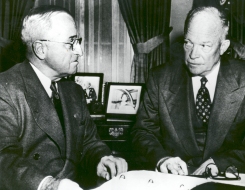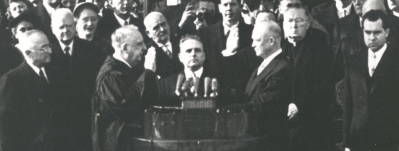Truman and Eisenhower: When the Man Who Loved Roads Met the Man Who Changed America
 At the White House, President Harry S. Truman (left) and President-Elect Dwight D. Eisenhower on November 19, 1952, discuss the upcoming transfer of power. Biographer Stephen E. Ambrose described the meeting as 'stiff, formal, embarrassing, and unrewarding'. Photo courtesy Dwight D. Eisenhower Library |
The article "The Man Who Loved Roads" discussed the relationship between President Harry S. Truman and General Dwight D. Eisenhower. In July 1945, on the autobahn in Germany, President Truman had told the victorious General Eisenhower, "General, there is nothing you may want that I won't try to help you get." That included, he said, the Presidency in 1948.
Since then, relations between the two had become embittered by political and other differences. During the 1952 presidential campaign against Governor Adlai Stevenson of Illinois, for example, General Eisenhower pledged to go to Korea to seek an end to the war, a promise he kept in November of that year. Truman had denounced the trip as demagoguery.
Then there was that campaign speech in Wisconsin, during which General Eisenhower intended to defend Secretary of State's George Marshall against allegations spread by Senator Joseph R. McCarthy of Wisconsin, then at the height of his demagogic power. The Senator had vilified Marshall repeatedly as part of a Communist conspiracy of infamy so immense that it surpassed "any venture" in history. Under pressure from McCarthy, Governor Walter Kohler, Jr., and members of his staff, Eisenhower agreed to delete the defense of his former wartime colleague. He also delivered a speech filled with Cold War anti-communist rhetoric. Communists, he claimed, had infiltrated the nation's schools, unions, news media, and government.
The Wisconsin crowd cheered, but Truman's assessment was blunt:
[It was] one of the most shocking things in the history of this country. The trouble with Eisenhower . . . he's just a coward . . . and he ought to be ashamed for what he did.
By Inauguration Day, January 20, 1953, President-elect Eisenhower had lost his normally sunny disposition when the subject of President Truman came up. Contemplating the trip the two would make from the White House to the Capitol, Eisenhower wondered aloud "if I can stand sitting next to that guy."
 January 20, 1953. Chief Justice Fred Vinson (second from left) administers the oath of office to the new President, Dwight David Eisenhower. Former President Harry S. Truman is to the left, and the new Vice President, Richard M. Nixon is on the right. Photo courtesy Dwight D. Eisenhower Library
|
Eisenhower even seemed to be going out of his way to irritate the outgoing President. He had decided, without consulting the President, to wear a Homburg rather than a silk top hat. Truman went along rather than fight over hats, but the incident increased the growing chill between the two men.
When Dwight and Mamie Eisenhower arrived at the White House to pick up the President for the ride to the Capitol, they not only refused to enter for a cup of coffee with the Trumans, but stayed in the vehicle until Truman came outside. CBS correspondent Eric Sevareid, who observed the incident, wrote, "It was a shocking moment." Head usher J. B. West put it this way: "I was glad I wasn't in that car."
The current and future Presidents' journey to the Capitol was a chilly one. In their memoirs, they would disagree about some of what was said. Both, however, would recall one bit of conversation. Eisenhower asked who had ordered his son John back from service in Korea for the occasion. Truman acknowledged that he had done so, later recalling that he said, "The President thought it was right and proper for your son to witness the swearing-in of his father to the Presidency."
After Chief Justice Fred Vinson administered the oath of office, President Eisenhower delivered an inaugural address in which he told the cheering listeners that, "Destiny has laid upon our country the responsibility of the free world's leadership." He added:
Knowing that only a United States that is strong and immensely productive can help defend freedom in our world, we view our Nation's strength and security as a trust upon which rests the hope of free men everywhere.
The inaugural parade was a 10-mile long procession that included marching bands, floats illustrating scenes from Eisenhower's life, a live turtle waving the American flag with its front legs, and a television cowboy, Montie Montana, who (with the permission of the Secret Service) lassoed the President.
Following the inauguration of the new President, Harry S. Truman went to Union Station for the train ride home to Independence, Missouri. Margaret Truman, in a biography of her father, described the scene:
At least 5,000 people were in the concourse, shouting and cheering. It was like the 1944 and 1948 conventions. The police had to form a flying wedge to get us to the [train]. Inside, the party started all over again. Newspaper men and women who had spent eight years tearing Dad apart came in to mumble apologies and swear they never meant a word of it.
Truman shook hands with and said goodbye to his Secret Service escort--once he left Washington, he would have no government protection.
The new President would have much to do. He would face the immediate problems first, including Korea, as all Presidents must. But somewhere down the line, he planned to do something about the Nation's roads. The road building community, which had been disappointed by President Truman, was optimistic about a new President who had included the following in a pre-election statement to the Hearst Newspapers:
The obsolescence of the nation's highways presents an appalling problem of waste, danger and death. Next to the manufacture of the most modern implements of war as a guarantee of peace through strength, a network of modern roads is as necessary to defense as it is to our national economy and personal safety.
We have fallen far behind in this task-until today there is hardly a city of any size without almost hopeless congestion within its boundaries and stalled traffic blocking roads leading beyond these boundaries. A solution can and will be found through the joint planning of the Federal, state and local governments.
The road builders had no idea how justified their optimism would prove to be.

